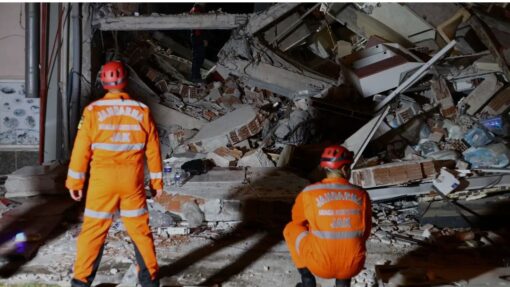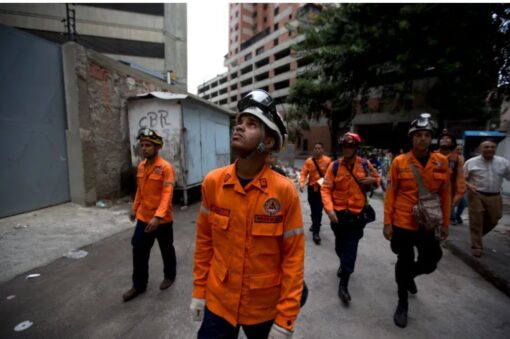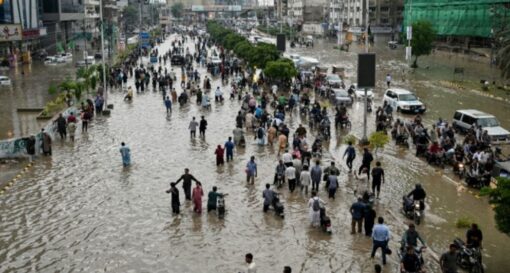A powerful earthquake measuring at least magnitude 6.1 has struck Venezuela, rattling communities across the country and sparking panic in several states, including the capital Caracas.
Tremors were also felt in neighboring Colombia, where residents reported buildings swaying and authorities briefly evacuated offices and homes.
The quake, although alarming in scale, has so far not resulted in any reported casualties or widespread destruction, offering a measure of relief to a country all too familiar with the devastating impact of seismic disasters.
The earthquake’s epicenter was recorded near Mene Grande in Zulia state, an oil-rich region located on the eastern coast of Lake Maracaibo.

This area holds critical significance for Venezuela’s struggling petroleum industry, which boasts the world’s largest proven reserves but continues to battle infrastructure decay, international sanctions, and declining output.
According to geological surveys, the quake struck at a relatively shallow depth, amplifying the strength of the tremors felt across populated areas.
In Caracas, office workers spilled into the streets as buildings shook for several seconds. Videos circulating on social media captured crowds gathering in open spaces, many speaking of their fear that the tremors could be the prelude to an even stronger aftershock.
While officials moved swiftly to reassure the public, the government’s communications channels acknowledged at least two additional seismic events detected shortly afterward in Barinas and Zulia states. Authorities described them as separate but related tremors that underscored the region’s vulnerability to tectonic activity.
Venezuela’s Civil Protection agency reported that emergency response teams were on standby across affected states, although no significant structural damage has been confirmed so far.
The absence of casualties has been attributed to both the quake’s offshore epicenter and the relatively brief duration of the tremors. In neighboring Colombia, authorities similarly confirmed no reports of serious damage, despite the widespread alarms. Nonetheless, the quake revived fresh anxiety in a country where memories of past tragedies remain vivid.
The seismic event highlights Venezuela’s geographical fragility. Situated near the boundary of the Caribbean and South American tectonic plates, the country is highly prone to earthquakes, with approximately 80 percent of its population living in active seismic zones.
In the last century alone, Venezuela has endured at least five major quakes, including the catastrophic 2018 earthquake off its northern coast that left more than 400 people dead and caused significant infrastructural collapse.
That disaster, regarded as one of the most powerful in recent history, underscored how unprepared the nation remains for seismic emergencies.
Public concern following the latest tremor has also reignited conversations about Venezuela’s preparedness for natural disasters. Years of economic crisis and political instability have weakened state institutions, leaving critical infrastructure vulnerable.
Hospitals, already overwhelmed by shortages of medicines and equipment, are feared to lack the capacity to manage a sudden influx of earthquake-related injuries.
Urban planners and engineers have long warned about the risks posed by older, poorly maintained buildings in Caracas and other densely populated areas.
Adding to the urgency is the precarious state of Venezuela’s energy infrastructure. Mene Grande, near the quake’s epicenter, is one of the oldest oil production hubs in the country.
Though no immediate damage has been reported to oil facilities, analysts caution that the quake could further strain an industry already battered by underinvestment. Any disruption to oil output would not only deepen Venezuela’s economic woes but also ripple through global energy markets at a time of heightened volatility.
Despite official reassurances, Venezuelans remain on edge. The unpredictability of aftershocks, combined with the memory of past quakes, has left many reluctant to return to high-rise offices and apartment blocks.
Some families have chosen to spend the night outdoors, fearing structural vulnerabilities in their homes. Schools in several regions announced temporary closures while authorities conducted structural assessments of buildings.
The earthquake also underscores the broader regional risks shared by South America’s northern coast. Colombia, which shares fault lines with Venezuela, has its own history of destructive quakes.
Seismologists warn that the interaction of tectonic plates in this area produces regular seismic activity, making preparedness and cross-border cooperation essential. The shallow depth of the latest quake suggests it could have been far more damaging had it struck closer to major population centers.
Experts argue that the relative lack of destruction this time should not lead to complacency. Instead, they view it as a reminder for both Venezuela and its neighbors to strengthen seismic monitoring systems, reinforce infrastructure, and invest in emergency response capabilities.
Climate-related pressures and rapid urbanization are already compounding disaster risks across the region, making resilience planning more urgent than ever.
For ordinary Venezuelans, however, the quake is yet another reminder of life’s daily uncertainties. In a nation grappling with economic hardship, political divisions, and mass emigration, natural disasters threaten to magnify human suffering.

Social media posts from residents expressed gratitude that the tremor did not claim lives, but also deep concern about what could happen if a stronger quake were to strike in the future.
As night fell, Caracas and other affected regions settled into a tense calm. Authorities urged citizens to remain alert for potential aftershocks and to follow safety protocols, while emergency services continued monitoring vulnerable structures.
Across Venezuela, families reflected on how precarious their lives have become, caught between political crises, economic collapse, and now the unpredictability of nature’s fury.
The 6.1 magnitude quake may ultimately pass into history as a wake-up call rather than a catastrophe. But its tremors have reverberated far beyond geology, stirring both fear and reflection in a nation struggling to balance on the fault lines of politics, economy, and survival.


